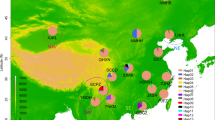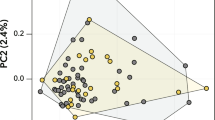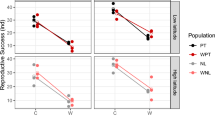Abstract
THE melanogaster subgroup in the Drosophila genus now includes six different species: four of them are found in tropical countries of the Ethiopian biogeographic region (D. yakuba Burla, D. teissieri Tsacas, D. erecta Tsacas and Lachaise, D. mauritiana Tsacas and David) whereas the two better known species, D. melanogaster and D. simulans, are widespread cosmopolitans. This geographical distribution is a strong argument for a tropical African origin of the subgroup1 and it suggests that genetically only two species were sufficiently versatile for adaptation to northern and southern temperate climates.
This is a preview of subscription content, access via your institution
Access options
Subscribe to this journal
Receive 51 print issues and online access
$199.00 per year
only $3.90 per issue
Buy this article
- Purchase on Springer Link
- Instant access to full article PDF
Prices may be subject to local taxes which are calculated during checkout
Similar content being viewed by others
References
Tsacas, L., and Lachaise, D., Ann. Univ. Abidjan, E 7, 193–211 (1974).
Dobzhansky, Th., in The Genetics of Colonizing species (edit. by Baker, H. G., and Stebbins, G. L.), 533–551 (Academic, New York, 1965).
Parsons, P. A., Behavioural and Ecological Genetics (Clarendon, Oxford, 1973).
David, J., and Bocquet, C., Experientia, 31, 164–166 (1975).
David, J., and Bocquet, C., Arch. Zool. exp. gén., 113, 451–463 (1972).
McKenzie, J. A., and Parsons, P. A., Oecologia, 10, 373–388 (1972).
David, J., Fouillet, P., and Arens, M. F., Arch. Zool. exp. gén., 115, 401–410 (1974).
Briscoe, D. A., Robertson, A., and Malpica, J. M., Nature, 255, 148–149 (1975).
Clarke, B., Genetics, 79, 101–113 (1975).
Vigue, C. L., and Johnson, F. M., Biochem. Genet., 9, 213–227 (1973).
Pipkin, S. B., Rhodes, C., and Williams, N., J. Hered., 64, 181–185 (1973).
Bijlsma-Meeles, E., and Van Delden, W., Nature, 247, 369–370 (1974).
Misra, R. K., and Reeve, E. C. R., Genet. Res., 5, 240–256 (1964).
Stalker, H. D., and Carson, H. L., Evolution, 1, 237–248 (1967).
Anderson, W. W., Evolution, 27, 278–284 (1973).
Lewontin, R. C., The Genetic Basis of Evolutionary Change (Columbia University Press, New York, 1974).
Carson, H. L., in The Genetics of Colonizing species (edit. by Baker, H. G., and Stebbins, G. L.), 503–531 (Academic, New York, 1965).
Fontdevila, A., Mendez, J., Ayala, F. J., and McDonald, J., Nature, 255, 149–151 (1975).
Author information
Authors and Affiliations
Rights and permissions
About this article
Cite this article
DAVID, J., BOCQUET, C. Similarities and differences in latitudinal adaptation of two Drosophila sibling species. Nature 257, 588–590 (1975). https://doi.org/10.1038/257588a0
Received:
Accepted:
Issue Date:
DOI: https://doi.org/10.1038/257588a0
This article is cited by
-
Ethanol-guided behavior in Drosophila larvae
Scientific Reports (2021)
-
The multilevel organismal diversity approach deciphers difficult to distinguish nudibranch species complex
Scientific Reports (2021)
-
Robustness of latitudinal life-cycle variations in a cricket Dianemobius nigrofasciatus (Orthoptera: Trigonidiidae) in Japan against climate warming over the last five decades
Applied Entomology and Zoology (2019)
-
Drosophila as models to understand the adaptive process during invasion
Biological Invasions (2016)
-
Genotype-environment interaction for total fitness in Drosophila
Journal of Genetics (2008)
Comments
By submitting a comment you agree to abide by our Terms and Community Guidelines. If you find something abusive or that does not comply with our terms or guidelines please flag it as inappropriate.



